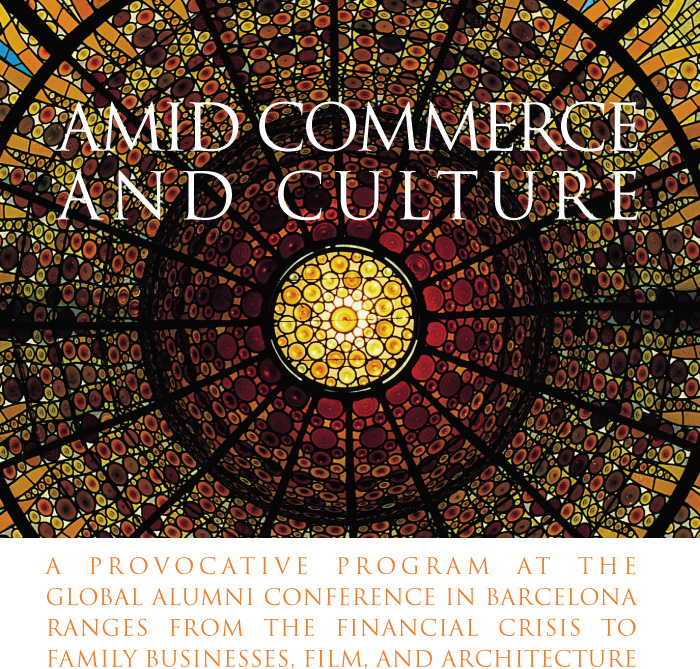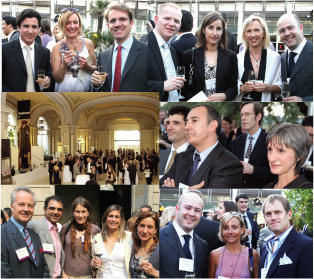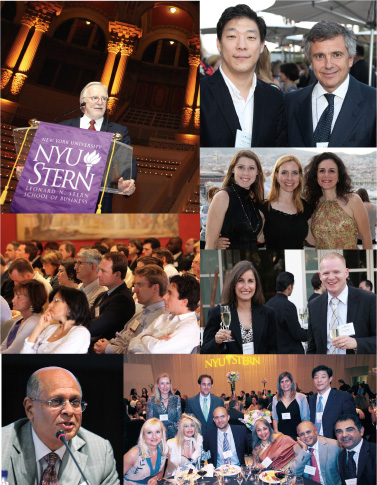
by Joanne Hvala
Barcelona is a jewel with many facets: gateway port to the Mediterranean, sun-drenched commercial capital, playground of wildly inventive chefs, seaside landscape of fantastical Gaudi architecture. Last June, this urban siren provided the vibrant backdrop for the 6th Annual Global Alumni Conference, held June 11-13 at the Casa Llotja, a 14th century building that is now the official home of the city’s Chamber of Commerce, Industry, and Shipping.
Nearly 300 Stern alumni, drawn from 25 countries, convened to hear a series of interviews and panels that focused on the financial crisis and its aftermath, as well as film, architecture, and NYU’s visionary plan for the Global Network University. The alumni host committee, chaired by Juan Antonio Samaranch-Salisachs (MBA ’86), assembled a stellar roster of speakers, many drawn from the Barcelona and Spanish business community. The Honorable Dr. Josep M. Basañez, First Vice Chairman of the Chamber of Commerce of Barcelona, who represented Barcelona Mayor Jordi Hereu i Boher, joined Dean Thomas Cooley in welcoming alumni and friends.

| Beyond the Square – Stern and the Global Network University
Washington Square may be the first location that comes to mind when NYU Stern is mentioned, but in the coming years, Stern will be part of a university that literally spans the globe. Stern’s participation in the NYU Global Network University was the subject of Dean of the Undergraduate College Sally Blount’s plenary session presentation, with co-presenter Hilary Ballon, Vice Chancellor for NYU Abu Dhabi Initiatives. Dean Blount is also Advisor to the President and Provost for Global Integration at NYU, working with the heads of NYU’s global and administrative units to create the infrastructure needed to realize the university’s vision of creating a large-scale, globally networked research university.
Seeds for the Global Network University were planted more than half a century ago, when NYU students began venturing to various European cities for accredited coursework. Today, nearly every continent has an NYU outpost where NYU students can spend a semester or year abroad. Over the past two years, the university’s administration has focused on creating an integrated network out of its many international programs. “The question is how best to create the infrastructure,” Dean Blount said, to enable students to move around the world as part of their education and to enable faculty to engage in the kind of scholarly exchange that enhances their areas of expertise.
At Stern, Dean Blount has spearheaded the School’s open-borders approach to undergraduate education. She has initiated several curricular innovations, including two new global degree options – the World Studies Track, launched in spring 2008, and the BS in Business and Political Economy, launched this fall. Students in these unique degree tracks will spend multiple semesters studying abroad in Europe, Asia, and Latin America as an integral part of their undergraduate education. “NYU is at the leading edge of what universities will look like in the 21st century,” Dean Blount said.
The student body has embraced the international curricula wholeheartedly. Some 800 high school seniors applied for 50 open spots in Stern’s new Business and Political Economy degree. About 75 percent of entering students will spend at least one semester abroad during their time at Stern. In addition, through the Edward and Nancy Barr Family International Studies Program (ISP), all juniors are required to take a course on a specific international region and make a week-long study visit there. “Last March, we had 200 students in Hong Kong, 200 in Budapest, and 200 in Buenos Aires,” Dean Blount said.
On the graduate level, the process of “interleaving” overseas study with the New York experience is also moving ahead. About 350 to 400 students go overseas each year, with most going to Melbourne, Hong Kong, Hyderabad, and Singapore through Doing Business in… (DBi) courses. The School already offers three global graduate degrees in concert with educational institutions in London, Paris, Hong Kong, and Amsterdam.
The global university concept is as solid financially as it is breathtaking academically. “This is a very robust model,” said Dean Blount. “With the possible exception of London, we can deliver programming more cost-effectively abroad.” NYU Abu Dhabi, to be located ultimately on a full campus on Saadiyat Island, is funded completely by the government of Abu Dhabi, Ballon said. NYU Abu Dhabi, set to welcome its first students in September 2010, will offer a full four-year liberal arts degree program.
The Global Network University project is a “high-risk, high-return bet,” Dean Blount conceded, but the potential upside has energized everyone concerned – including session attendees in Barcelona, one of whom declared he was ready to do college over again – if it was at the Global Network University. |
|
Different Strokes
Keynote speaker Jordi Gual, chief economist at La Caixa, Spain’s leading savings bank, and professor of economics at IESE Business School, provided a nuanced tutorial on the financial crisis, describing the current situation, comparing and contrasting the effects on the real economy in the US and Europe, and outlining the key elements needed for a sustainable recovery. Although mentioning glimmers of hope, he warned of a deep, global recession that is having a different impact on different countries, and that will have long-lasting effects. Fiscal policy has responded more aggressively in the US, while Europe has been more cautious and reliant on monetary policy. While unemployment is increasing in the US, in Europe the welfare state is cushioning the recession – a good short-term strategy, he said, but in the longer term it could impair labor mobility and change.
Another perspective on the financial crisis was given by Alfredo Saenz, CEO of Banco Santander, SA, the world’s largest branch bank, who was interviewed by Stern’s Roy Smith, Kenneth Langone Professor of International Business, in a “Chat with Financiers” segment of the program. Banco Santander had an extraordinarily good year in 2008 – booking 9 billion euros in profits. Observing the financial crisis, however, Saenz asserted that poor risk management was at fault. “You need to have independent risk management and get the board of directors involved. We have had these rules since I was born.”
Room for Improvement
Rounding out the financial program, Stern Professor Edward Altman, Max L. Heine Professor of Finance, moderated a panel of alumni representing three generations who tackled the topic of “Restructuring and Credit Markets in 2009-2010.”
Speaking of “systemic gullibility,” Mark Patterson (MBA ’86), chairman and co-founder, MatlinPatterson Global Advisers LLC, highlighted the amount of leverage in the system, citing residential real estate and estimating $200 to $300 billion in commercial real estate write-offs to come. He predicted that the recovery wouldn’t happen until $4 trillion in write-offs had been completed, and added: “We have moved leverage from the basement to the upstairs – to sovereign government debt. This is scary.”
 Fabio Cane (MBA ’90), head of investment banking, Intesa Sao Paolo, criticized the “exaggerated incentive system” and “no sense of ownership.” Final buyers, he said, did not understand the enormous risk of the financial instruments they were buying, the ones that rating agencies rated triple-A. The financial crisis has offered many opportunities for restructuring, said Tony C. Alvarez II (MBA ’76), founder and co-CEO, Alvarez & Marsal, and a turnaround expert who was tapped to handle Lehman Brothers’ restructuring. “We are seeing the globalization of restructuring,” he said.
Fabio Cane (MBA ’90), head of investment banking, Intesa Sao Paolo, criticized the “exaggerated incentive system” and “no sense of ownership.” Final buyers, he said, did not understand the enormous risk of the financial instruments they were buying, the ones that rating agencies rated triple-A. The financial crisis has offered many opportunities for restructuring, said Tony C. Alvarez II (MBA ’76), founder and co-CEO, Alvarez & Marsal, and a turnaround expert who was tapped to handle Lehman Brothers’ restructuring. “We are seeing the globalization of restructuring,” he said.
Indie Films Rule
Discussing risk from the perspective of film rather than finance, Marketing Professor Al Lieberman, executive director of Stern’s Entertainment, Media and Technology program, interviewed Michael Barker, co-president and co-founder, Sony Pictures Classics, whose career breakthrough moment came when he negotiated with film director François Truffaut for North America distribution of “The Last Metro” and later brought Spanish director Pedro Almodóvar’s work to an American audience. Speaking about “The Independent Film: The Growth of Global Cinema,” Barker began by calling Stern’s entertainment business track “the best program of its kind in the country.” Contrasting indie films with big-budget blockbuster releases, Barker explained: “There is a totally separate independent film business with a different set of economics. Overspend on marketing and you kill the profit; under-spend and there is no profit.”
Old Family Recipes
The concluding conference session offered alumni the choice of panels on two very different engines for economic growth – the family business or architecture and urban development – both offering abundant examples in the Spanish economy.
Stern’s Marti Subramanyam, Charles E. Merrill Professor of Finance, moderated “Family Business in the 21st Century: An Anachronism or an Institution for Economic Growth and Stability?” Subramanyam pointed out the importance of family business as an institution in Europe and Asia. “Even in the US, one-third of the businesses are indirectly controlled by families – think of Wal-Mart and Johnson & Johnson,” he noted.
Marc Puig, chairman and CEO of a third-generation family business, The Puig Beauty and Fashion Group, observed that family businesses have different priorities than private equity and explained, “You are working for something that goes beyond one’s own existence.” Claudio Boada, chairman of Circulo de Empresarios, an organization comparable to the Business Roundtable, added, “Family businesses tend to be more profitable than non-family businesses, and therefore tend to last longer – 20 percent last beyond the third generation.”
The panelists attributed the success of family businesses to their conservative grounding in tradition, which fosters a long-term focus, and their close attention to cash, particularly in the efficient use of working capital and higher investment in R&D. A chief concern is succession planning, critical to ensuring the longevity of the business.
 “Research shows that the combination of family ownership and professional management provides the best of both worlds,” said Alejandro Beltran, managing director of McKinsey Spain, who had his own experience with a family-owned construction company.
“Research shows that the combination of family ownership and professional management provides the best of both worlds,” said Alejandro Beltran, managing director of McKinsey Spain, who had his own experience with a family-owned construction company.
The Art of Urban Development
The renaissance of Barcelona that was prompted by the 1992 hosting of the Olympic Games was just one thread of the panel’s discussion of “Architecture and Urban Development as Engines for Economic Growth,” moderated by Hilary Ballon, professor of urban studies and architecture at NYU Wagner and Vice Chancellor for NYU Abu Dhabi Initiatives.
Josep Anton Acebillo Marin, CEO of Barcelona Regional, SA, recalled the lessons learned from the redevelopment of Barcelona in preparation to host the Olympics, not least of which was the challenge of reclaiming 20 hectares from the sea. Jerry Cohen (BS ’53, MBA ’59), a partner in Tishman Speyer Properties, described another daunting project – building a tower over the historic Hearst Building in New York City – which involved difficult zoning issues relating to melding a landmark property with a contemporary tower while incorporating the latest in “green” building techniques and materials.
Beatriz Plaza, professor of economics at the University of the Basque Country, highlighted the importance to the local tourist economy of the Gehry-designed Guggenheim Museum in the Basque city of Bilbao. “Bilbao is an industrial city,” she explained, and the choice of an “iconic” builder was essential for the project to move forward. Plaza quantified the benefit of the new museum in numbers of tourists and the discounted cash flow of incremental taxes related to tourism. Built in 1997, the Bilbao Museum had recouped its investment by 2006, and Plaza also credited it with adding 8,000 local jobs.
Praising the public life in Barcelona, Robert Campbell, the Pulitzer-prize-winning architectural correspondent for The Boston Globe, attributed its quality to population density, naming Cambridge, Mass., Paris, and Manhattan as other successful examples of dense cities conducive to social and intellectual interaction. These “cities of ideas” can be anywhere, he said, but depend on infrastructure. “The art of infrastructure is the art of design,” he said.
The conference formally concluded with a reception and closing dinner at the Museu Nacional d’Art de Catalunya at the Palau Nacional (pictured on the cover). Before dinner, alumni had time to tour the permanent exhibit of Romanesque art that features restored frescoes recovered from more than a dozen small churches in remote areas. Following dinner, alumni enjoyed classical guitar music by The Barcelona Guitar Orchestra. Professor Smith toasted Dean Thomas Cooley for his leadership and service to the Stern School, leading the alumni audience in a rousing crescendo of “Olés.”
Visit www.stern.nyu.edu/barcelona to view videos of the full presentations, additional photos, and more from the Conference.


![]()